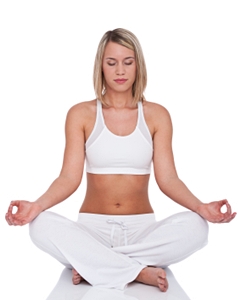Yoga Styles and Poses
 Fitness series - Blond woman in yoga position on white background
Fitness series - Blond woman in yoga position on white background
There are several different yoga styles and poses. You can choose depending on your particular need, the more popular styles are:
a) Hatha Yoga: Hatha yoga is the generic term used to describe the different types of yoga and is the most popular type practiced in the west. The word “Hatha” is a Sanskrit word, made up of “Ha” – sun and “that” – moon. So, Hatha yoga literally means sun and moon joining together as one. The sun and moon represents the masculine/active (sun) and feminine/receptive (moon/lunar) principles as the opposing polarities of life. The idea is to find the balance between the two opposing qualities which suits your particular needs. Between a very physically challenging practice and a very gentle style. When these are in balance, you have perfect health, energy and vitality. This forms the core of what most yoga students seek.
b) Sivananda Hatha Yoga: This style of yoga focus on 12 basic classical postures, relaxation and breathing exercises also form a key part of a class. Most Sivananda classes will include an element of chanting and spiritual discourse. Founded by Swamiji Sivananda, this form of yoga is considered a fairly gentle to moderate pace and good introduction into yoga.
c) Iyengar Yoga: BKS Iyengar is the famous yoga teacher associated with this style of yoga. In Iyengar yoga, great emphasis is placed on alignment and uses of props to support the body achieve the poses. Again, Iyengar yoga is considered a good introduction to yoga, especially with its strong emphasis on posture alignment and anatomy.
d) Astanga Yoga: Considered a more strenuous form of yoga and definitely more physically challenging than Sivananda or Iyengar, Astanga yoga is very good for those who like a physical dynamic practice. You are taught a sequence and over time encouraged to self practice. It is best suited to students who are reasonable fit and in good health and in my view, looking for a “work out”. Pattabhi Jois is the founder of this style of yoga.
e) Bikram Yoga: Some people refer to Bikram Yoga as “Hot Yoga” as it is taught in rooms which are heated to at least 38 degree Celsius. The room is as hot as a sauna. As a beginner, it is essential you are in reasonable health and feel comfortable in learning yoga in a hot environment. You will sweat a lot. Founded by Bikram Choudury, this system of yoga consists of you learning 26 basic postures.
What Are The Similarities Between These Yoga Styles?
Regardless of the “style” of yoga you chose, all yoga class consists of a mixture of the following four main areas:
a) Stretching Exercises/Poses known as asanas.
b) Breathing Practices known as pranayama designed to cleanse the body and calm the nervous system and emotions. Some schools of yoga place a lot of emphasis on learning breathing exercises. So if that interests you, chose a class where that is taught.
c) Guided Relaxation to release body tension and promote a sense of well-being. Again, check with your teacher how much emphasis is placed on that in her class.
d) Meditation and Chanting –Meditation helps to calm and focus your mind and encourage you to experience a sense of inner peace. If you are interested in meditation, again check with your teacher how that is structured into the class and what type of meditation is taught. Some schools of yoga do not include chanting whereas others do.
Conclusion Given the popularity of yoga classes on offer, it is understandable that my potential student felt confused about what class to join. I would suggest, try out a few taster classes or workshops, talk to yoga students – they are a friendly bunch. At the end of the day, you have to choose a class and style of yoga where you feel comfortable with the teacher and trust your inner wisdom.

Leave a comment